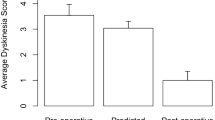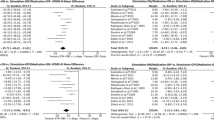Abstract
The purpose of this paper is to describe the effect of 5 years of subthalamic nucleus deep brain stimulation (STN DBS) on levodopa-induced complications, both in everyday life and during an acute challenge with levodopa. Thirty three patients were evaluated during an acute levodopa challenge before surgery and then 1 and 5 years afterwards (both off stim and on stim), using the UPDRS III scale and the CAPSIT-PD scales for dystonia and peak-dose dyskinesia. The UPDRS IV scale was used to assess motor complications in everyday life. The levodopa daily dose and DBS parameters were also recorded. Levodopa-induced complications in everyday life (UPDRS IV) and during an acute levodopa challenge had improved markedly after 1 year (both on and off stim) and still further at 5 years. Peak-dose dyskinesia decreased between the 1- and 5-year measurements. STN DBS decreases levodopa-induced motor complications over the long term. This phenomenon may be explained by (a) overall stabilization of the basal ganglia network and (b) striatal synaptic changes. Our results suggest that DBS leads to both qualitative and quantitative modulations in the corticostriatal loops.


Similar content being viewed by others
References
Bejjani BP, Arnulf I, Demeret S, Damier P, Bonnet AM, Houeto JL, Agid Y (2000) Levodopa-induced dyskinesias in Parkinson’s disease: is sensitization reversible? Ann Neurol 47:655–658
Benabid AL, Chabardes S, Seigneuret E (2005) Deep-brain stimulation in Parkinson’s disease: long-term efficacy and safety—what happened this year? Curr Opin Neurol 18:623–630
Brotchie JM, Lee J, Venderova K (2005) Levodopa-induced dyskinesia in Parkinson’s disease. J Neural Transm 112:359–391
Ceballos-Baumann AO (2003) Functional imaging in Parkinson’s disease: activation studies with PET, fMRI and SPECT. J Neurol 250(Suppl 1):I15–I23
Ceballos-Baumann AO, Boecker H, Bartenstein P, von Falkenhayn I, Riescher H, Conrad B, Moringlane JR, Alesch F (1999) A positron emission tomographic study of subthalamic nucleus stimulation in Parkinson disease: enhanced movement-related activity of motor-association cortex and decreased motor cortex resting activity. Arch Neurol 56:997–1003
Cenci MA, Lindgren HS (2007) Advances in understanding l-DOPA-induced dyskinesia. Curr Opin Neurobiol 17:665–671
Defer GL, Widner H, Marie RM, Remy P, Levivier M (1999) Core assessment program for surgical interventional therapies in Parkinson’s disease (CAPSIT-PD). Mov Disord 14:572–584
Fraix V, Pollak P, Van Blercom N, Xie J, Krack P, Koudsie A, Benabid AL (2000) Effect of subthalamic nucleus stimulation on levodopa-induced dyskinesia in Parkinson’s disease. Neurology 55:1921–1923
Gibb WR, Lees AJ (1989) The significance of the Lewy body in the diagnosis of idiopathic Parkinson’s disease. Neuropathol Appl Neurobiol 15:27–44
Graybiel AM (2004) Network-level neuroplasticity in cortico-basal ganglia pathways. Parkinsonism Relat Disord 10:293–296
Hershey T, Black KJ, Stambuk MK, Carl JL, McGee-Minnich LA, Perlmutter JS (1998) Altered thalamic response to levodopa in Parkinson’s patients with dopa-induced dyskinesias. Proc Natl Acad Sci USA 95:12016–12021
Herzog J, Pinsker M, Wasner M, Steigerwald F, Wailke S, Deuschl G, Volkmann J (2007) Stimulation of subthalamic fibre tracts reduces dyskinesias in STN-DBS. Mov Disord 22:679–684
Hilker R, Portman AT, Voges J, Staal MJ, Burghaus L, van Laar T, Koulousakis A, Maguire RP, Pruim J, de Jong BM, Herholz K, Sturm V, Heiss WD, Leenders KL (2005) Disease progression continues in patients with advanced Parkinson’s disease and effective subthalamic nucleus stimulation. J Neurol Neurosurg Psychiatry 76:1217–1221
Jenkins IH, Fernandez W, Playford ED, Lees AJ, Frackowiak RS, Passingham RE, Brooks DJ (1992) Impaired activation of the supplementary motor area in Parkinson’s disease is reversed when akinesia is treated with apomorphine. Ann Neurol 32:749–757
Krack P, Batir A, Van Blercom N, Chabardes S, Fraix V, Ardouin C, Koudsie A, Limousin PD, Benazzouz A, LeBas JF, Benabid AL, Pollak P (2003) Five-year follow-up of bilateral stimulation of the subthalamic nucleus in advanced Parkinson’s disease. N Engl J Med 349:1925–1934
Limousin P, Martinez-Torres I (2008) Deep brain stimulation for Parkinson’s disease. Neurotherapeutics 5:309–319
Linazasoro G (2005) New ideas on the origin of l-dopa-induced dyskinesias: age, genes and neural plasticity. Trends Pharmacol Sci 26:391–397
Liu Y, Postupna N, Falkenberg J, Anderson ME (2008) High frequency deep brain stimulation: what are the therapeutic mechanisms? Neurosci Biobehav Rev 32:343–351
Piboolnurak P, Lang AE, Lozano AM, Miyasaki JM, Saint-Cyr JA, Poon YY, Hutchison WD, Dostrovsky JO, Moro E (2007) Levodopa response in long-term bilateral subthalamic stimulation for Parkinson’s disease. Mov Disord 22:990–997
Picconi B, Centonze D, Hakansson K, Bernardi G, Greengard P, Fisone G, Cenci MA, Calabresi P (2003) Loss of bidirectional striatal synaptic plasticity in l-DOPA-induced dyskinesia. Nat Neurosci 6:501–506
Picconi B, Paille V, Ghiglieri V, Bagetta V, Barone I, Lindgren HS, Bernardi G, Angela Cenci M, Calabresi P (2008) l-DOPA dosage is critically involved in dyskinesia via loss of synaptic depotentiation. Neurobiol Dis 29:327–335
Rascol O, Sabatini U, Brefel C, Fabre N, Rai S, Senard JM, Celsis P, Viallard G, Montastruc JL, Chollet F (1998) Cortical motor overactivation in parkinsonian patients with l-dopa-induced peak-dose dyskinesia. Brain 121(Pt 3):527–533
Rektorova I, Sedlackova S, Telecka S, Hlubocky A, Rektor I (2008) Dorsolateral prefrontal cortex: a possible target for modulating dyskinesias in Parkinson’s disease by repetitive transcranial magnetic stimulation. Int J Biomed Imaging 2008:372125
Schrag A, Quinn N (2000) Dyskinesias and motor fluctuations in Parkinson’s disease. A community-based study. Brain 123(Pt 11):2297–2305
Schupbach WM, Chastan N, Welter ML, Houeto JL, Mesnage V, Bonnet AM, Czernecki V, Maltete D, Hartmann A, Mallet L, Pidoux B, Dormont D, Navarro S, Cornu P, Mallet A, Agid Y (2005) Stimulation of the subthalamic nucleus in Parkinson’s disease: a 5 year follow up. J Neurol Neurosurg Psychiatry 76:1640–1644
Sestini S, Pupi A, Ammannati F, Silvia R, Sorbi S, Castagnoli A (2007) Are there adaptive changes in the human brain of patients with Parkinson’s disease treated with long-term deep brain stimulation of the subthalamic nucleus? A 4-year follow-up study with regional cerebral blood flow SPECT. Eur J Nucl Med Mol Imaging 34:1646–1657
Sestini S, Ramat S, Formiconi AR, Ammannati F, Sorbi S, Pupi A (2005) Brain networks underlying the clinical effects of long-term subthalamic stimulation for Parkinson’s disease: a 4-year follow-up study with rCBF SPECT. J Nucl Med 46:1444–1454
Tir M, Devos D, Blond S, Touzet G, Reyns N, Duhamel A, Waucquier N, Cottencin O, Dujardin K, Debailleul AM, Cassim F, Destee A, Defebvre L, Krystkowiak P (2007) Exhaustive, one-year follow-up of subthalamic nucleus deep brain stimulation in a large, single-center cohort of Parkinsonian patients. Neurosurgery 61:297–304
Volkmann J, Allert N, Voges J, Weiss PH, Freund HJ, Sturm V (2001) Safety and efficacy of pallidal or subthalamic nucleus stimulation in advanced PD. Neurology 56:548–551
Welter ML, Houeto JL, Tezenas du Montcel S, Mesnage V, Bonnet AM, Pillon B, Arnulf I, Pidoux B, Dormont D, Cornu P, Agid Y (2002) Clinical predictive factors of subthalamic stimulation in Parkinson’s disease. Brain 125:575–583
Wider C, Villemure JG, Pollo C, Bogousslavsky J, Burkhard PR, Vingerhoets F (2006) Outcome in 50 consecutive advanced PD patients treated with STN-DBS for 4 to 7 years. Neurology 66:A196
Conflict of interest statement
The authors have no conflicts of interest to report.
Author information
Authors and Affiliations
Corresponding author
Rights and permissions
About this article
Cite this article
Simonin, C., Tir, M., Devos, D. et al. Reduced levodopa-induced complications after 5 years of subthalamic stimulation in Parkinson’s disease: a second honeymoon. J Neurol 256, 1736–1741 (2009). https://doi.org/10.1007/s00415-009-5195-2
Received:
Revised:
Accepted:
Published:
Issue Date:
DOI: https://doi.org/10.1007/s00415-009-5195-2




